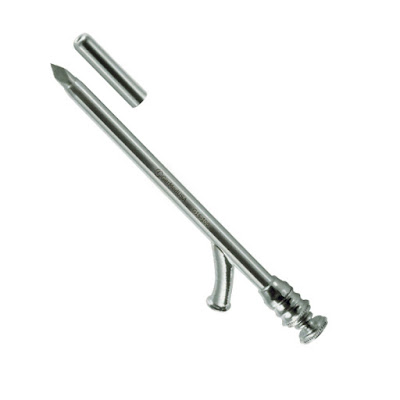iData Research estimates that over 13 million laparoscopic operations are performed annually around the world. These are minimally invasive procedures in which the surgeons make small incisions with the help of surgical trocars.
Trocars are ideal tools that eliminate the need to make large incisions to access the abdomen. Surgeons use various types of trocars to make holes in the body for intra-abdominal access.
In this article, we will discuss the top 6 trocars a surgeon should have in his surgical kit. Let’s get started!
Why do Surgeons Need Trocars?
Surgeons mainly use trocars during laparoscopic surgical procedures for making puncture-like incisions in the outer layers of body tissues. The tool allows the insertion of the cannulas so that surgeons can use other surgical instruments on the surgical site. As a result, the trocar functions as a portal for the subsequent placement of other surgical instruments.
In addition, the sharp triangular point end of the trocar allows escaping of the fluid or gasses from the organs. Surgeons insert the trocar in the deepest part of the umbilicus to make a parietal peritoneal puncture.
What Are the Different Types of Surgical Trocars?
There are different types of trocars on the basis of material and structure. The material-based trocars are disposable and reusable. Generally, the trocars are of two types:
- Cutting trocars
- Dilating trocars
Cutting trocars consist of sharp plastic metal blades that surgeons use to cut the layers of tissues. They are specifically designed to access the subcutaneous cavities, such as abdominal cavities.
On the other side, dilating trocars consist of blunt tips that surgeons use to dilate and separate tissues. They are usually known as non-cutting trocars as they minimize the risk of injury to the internal organs during surgical procedures.
Besides, there are several other types of trocars used in various surgeries. Let’s discuss them in detail.
Ochsner Trocar Catheters
Ochsner Trocar Catheter is a unique type of trocar with a sharp pointed tip for precisely making incisions in soft tissues. Surgeons use it for draining out the fluid from fluid-filled cavities during paracentesis or other procedures.
The instrument is useful for draining the mucus or pus that resides in the gallbladder. In addition, the tuning connection of Ochsner Trocar makes it highly efficient for use in abdominal procedures.
Patterson Trocar
Patterson Trocar is a commonly used trocar during cardiothoracic surgical procedures for removing gas or fluids. The instrument features a bulb-shaped handle that perfectly fits in the surgeon’s hand during the surgery.
This handle extends towards a long shaft with a sharp pen-type tip. Surgeons can make safe insertions with the Patterson Trocar to withdraw fluids through intercostal penetration. The instrument is available in different sizes as the surgeons can select the best fit tool according to the need.
Duke Trocar and Cannula
Duke Trocar and Cannula are ideal surgical instruments for draining body fluids and gasses. Surgeons insert the cannula, which is a long shaft, into the patient’s surgical site to access the abdominal cavity.
They consist of sharp pen-shape tips and perforated tubes for easy removal of the fluid. Duke Trocar and Cannula have a standard length of 4 ½”, which is enough for intercoastal insertion. Surgeons use them in laparoscopic and other minimally invasive procedures for the drainage outlet.
Nested Trocars
A Nested Trocar is a uniquely designed surgical instrument with trocar points to drain the fluid from the gallbladder. The instrument has a flat chrome plated handle that surgeons can comfortably grip during the laparoscopic surgical procedure.
The chromium plating in the handle reduces the friction between the instrument surface and the surgeon’s hand, allowing safe surgical procedures. It also makes the surface non-sticky, which is easy to clean and sterilize.
Universal Trocar
The universal trocar consists of a sharp or blunt tip that general or abdominal surgeons use for smooth tissue dissection. The instrument is ideal for making a hole into the body cavity to permit the withdrawal of fluid and insertion of an endoscope or cannula. In addition, surgeons use them during laparoscopic procedures for the examination of the internal organs of the body.
Birch Trocar
The Birch Trocar is the ideal type of trocar, with a sharp tip and thick, flat handle. Surgeons use it to puncture the body cavities for internal abdominal access. In addition, it has an overall length of 7”, which is suitable for accessing the internal body organs.
Where to Get High-Quality Trocars?
Surgical trocars are ideal surgical instruments for puncturing and dissecting the outer tissues of the body in order to drain the fluid and gas within the organs. Surgeons commonly use them during laparoscopic and minimally inNvasive surgeries for diagnosis purposes.
You can get them from GerMedUSA. They provide fine-quality German stainless steel surgical instruments in various designs and sizes. So you can get the best-fit surgical instruments according to your choice. The good thing is that they also offer customization, as they are the manufacturers of surgical tools. Visit the website for more information.
FAQs
What are the demerits of reusing disposable trocars?
Plastic trocars require a high level of disinfection; otherwise, they cause a potential risk of transmitting diseases like HIV and hepatitis. That is why it is better not to reuse disposable trocars.
What are trocars made of?
The trocars are either made of plastic or metal, which can differentiate their use for long-term durations. The stainless-steel trocars are sterilizable, which is why surgeons can reuse them multiple times. On the other hand, plastic trocars are for single use only.
Can the trocar cause any complications during surgery?
The direct inserting technique of inserting the trocar can cause complications during surgical procedures. The open technique is the safest approach while inserting trocars.

Post a Comment